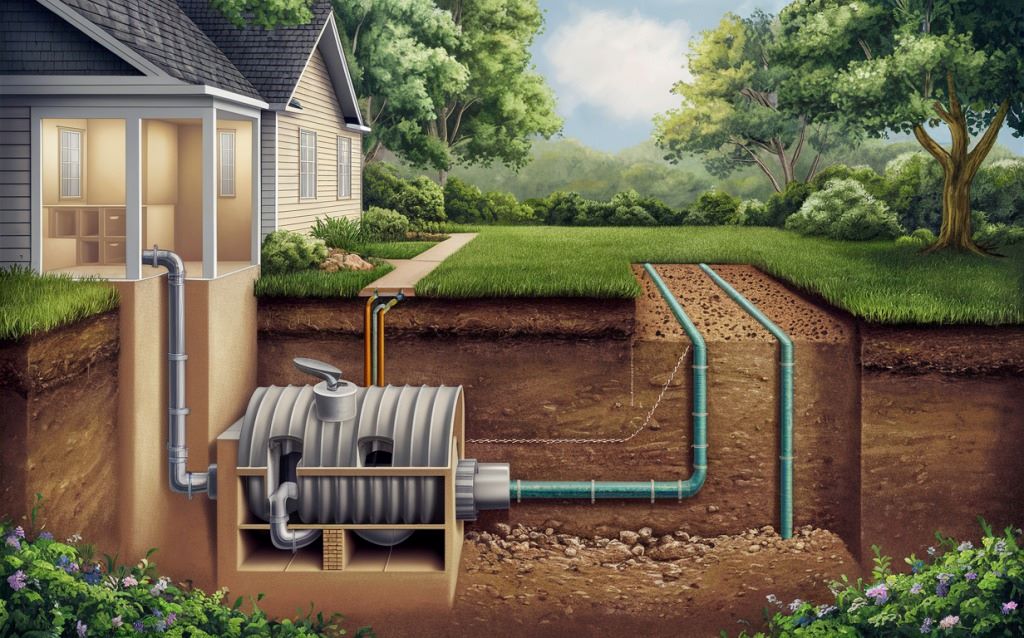In a world increasingly conscious of its environmental footprint, the seemingly mundane septic system has become a focal point for sustainable living. While often relegated to the realm of “out of sight, out of mind,” these vital systems play a crucial role in wastewater management, particularly in areas lacking centralized sewer infrastructure. However, traditional septic systems, with their reliance on soil absorption and potential for nutrient leaching, can pose environmental risks. As homeowners and communities seek greener alternatives, the question arises: what is the most environmentally friendly septic system?
This article delves into the nuances of eco-conscious wastewater treatment, exploring various septic system technologies and their environmental impact, ultimately guiding you towards making an informed and sustainable choice.
Understanding the Environmental Concerns of Traditional Septic Systems:
Before exploring alternatives, it’s crucial to understand the environmental concerns associated with traditional septic systems. These systems typically consist of a septic tank where solids settle and anaerobic bacteria break down organic matter, followed by a drainfield where the effluent infiltrates the soil for further treatment. However, several environmental issues can arise:
- Nutrient Leaching: Excess nitrogen and phosphorus from inadequately treated wastewater can leach into groundwater and surface water, leading to eutrophication – excessive algal growth that depletes oxygen and harms aquatic ecosystems.
- Pathogen Contamination: If the designer or maintainer poorly designs or neglects the drainfield, or if the soil is unsuitable, pathogens like bacteria and viruses can contaminate groundwater, posing risks to human health.
- Soil Compaction and Clogging: Over time, the drainfield can become compacted or clogged with solids, reducing its ability to treat wastewater effectively and potentially leading to system failure.
- Limited Nutrient Removal: Traditional systems primarily focus on solids removal and partial biological treatment, offering limited removal of nutrients and other contaminants.
Emerging Technologies: The Quest for Greener Septic Solutions:
Recognizing the environmental limitations of traditional systems, researchers and manufacturers have developed innovative technologies aimed at improving wastewater treatment and minimizing environmental impact. These systems often incorporate advanced treatment processes and materials, offering enhanced nutrient removal and pathogen reduction.
-
Aerobic Treatment Units (ATUs): Mimicking Nature’s Cleansing Power:
ATUs are a significant step towards environmentally friendly septic systems. Unlike traditional systems that rely on anaerobic bacteria, ATUs introduce oxygen into the treatment process, promoting the growth of aerobic bacteria. These bacteria are significantly more efficient at breaking down organic matter and removing nutrients, resulting in a cleaner effluent.
- How They Work: ATUs typically include a pretreatment tank, an aeration chamber where the system injects air to support aerobic bacteria, and a clarification chamber where solids settle. The system then discharges the resulting effluent into a drainfield or another dispersal system.
- Environmental Benefits: ATUs significantly reduce nutrient leaching, minimize pathogen contamination, and produce a higher-quality effluent compared to traditional systems. They are particularly suitable for areas with sensitive water resources or limited soil absorption capacity.
- Considerations: ATUs require electricity to operate the aeration system, and regular maintenance is essential to ensure optimal performance.
-
Constructed Wetlands: Nature’s Ingenious Filters:
Constructed wetlands are engineered systems that mimic natural wetlands, utilizing plants, soil, and microorganisms to treat wastewater. They offer a sustainable and aesthetically pleasing alternative to traditional septic systems.
- How They Work: Wastewater flows through a series of shallow basins planted with aquatic vegetation. The plants and their associated microorganisms remove nutrients, pathogens, and other contaminants from the water.
- Environmental Benefits: Constructed wetlands provide excellent nutrient removal, reduce pathogen contamination, and create valuable habitat for wildlife. They are also low-energy systems, relying on natural processes for treatment.
- Considerations: Constructed wetlands require a larger land area compared to other septic systems, and the treatment process can be influenced by climate and seasonal variations.
-
Biofilters: Engineered for Efficiency:
Biofilters are another promising technology for environmentally friendly septic systems. They utilize engineered media, such as sand, gravel, or peat, to support the growth of microorganisms that treat wastewater.
- How They Work: Wastewater flows through the filter media, where microorganisms attached to the media surfaces break down organic matter and remove nutrients. The treated effluent is then discharged into a drainfield or other dispersal system.
- Environmental Benefits: Biofilters offer high treatment efficiency, compact design, and flexibility in adapting to various site conditions. They can achieve significant nutrient removal and pathogen reduction.
- Considerations: Biofilters require periodic maintenance to replace or clean the filter media, and the treatment performance can be affected by the type and quality of the media used.
-
Advanced Treatment Systems (ATS): Tailored for Specific Needs:
ATS encompass a range of technologies that combine various treatment processes to achieve specific water quality goals. These systems may include membrane bioreactors, nutrient removal systems, and disinfection units.
- How They Work: ATS are designed to meet stringent effluent quality standards, often required in sensitive environmental areas or for water reuse applications. They can achieve very high levels of nutrient removal and pathogen reduction.
- Environmental Benefits: ATS offer the highest level of environmental protection, producing effluent that can be safely discharged or reused for irrigation or other non-potable purposes.
- Considerations: ATS are typically more expensive and complex than other septic systems, requiring specialized expertise for design, installation, and maintenance.

Choosing the Most Environmentally Friendly System: A Holistic Approach:
Determining the “most” environmentally friendly septic system depends on various factors, including site conditions, treatment goals, and budget. However, a holistic approach that considers the following factors is essential:
- Nutrient Removal: Prioritize systems that achieve high levels of nitrogen and phosphorus removal to minimize eutrophication.
- Pathogen Reduction: Select systems that effectively reduce pathogen contamination to protect groundwater and human health.
- Energy Consumption: Opt for systems with low energy consumption and utilize renewable energy sources whenever possible.
- Material Selection: Choose systems that utilize sustainable and durable materials with minimal environmental impact.
- Life Cycle Assessment: Consider the environmental impact of the entire life cycle of the system, including manufacturing, installation, operation, and disposal.
- Proper Maintenance: Regardless of the system chosen, regular maintenance is crucial for optimal performance and environmental protection.
People Also Ask (FAQs):
Q: Are aerobic septic systems better for the environment?
A: Yes, aerobic septic systems, such as ATUs, are generally considered better for the environment compared to traditional anaerobic systems. They offer significantly higher nutrient removal and pathogen reduction, resulting in a cleaner effluent.
Q: Do septic systems pollute groundwater?
A: Traditional septic systems can pollute groundwater if they are poorly designed, installed, or maintained, or if the soil is unsuitable. However, advanced treatment systems and properly functioning aerobic systems minimize the risk of groundwater contamination.
Q: How often should a septic tank be pumped?
A: The frequency of septic tank pumping depends on the size of the tank and the number of people in the household. Generally, it is recommended to pump the tank every 3-5 years.
Q: Can I use greywater for irrigation?
A: Greywater, which is wastewater from showers, sinks, and laundry, can irrigate plants if properly treated. Some advanced septic systems and greywater recycling systems facilitate this process. However, homeowners should consult local regulations before implementing greywater irrigation.
Q: Are there any eco-friendly septic tank additives?
A: While some companies claim that septic tank additives improve system performance, there is limited scientific evidence to support their effectiveness. Experts generally recommend focusing on proper system design, installation, and maintenance instead of relying on additives.
Q: What is the cost difference between traditional and advanced septic systems?
A: Advanced septic systems, such as ATUs and biofilters, are typically more expensive than traditional systems due to their advanced treatment technologies and components. However, the environmental benefits and potential for water reuse can justify the higher cost in the long run.
Conclusion: Embracing Sustainable Wastewater Management:
The quest for the most environmentally friendly septic system is an ongoing journey, driven by innovation and a growing awareness of our environmental responsibility. While there is no single “best” solution, advanced technologies like ATUs, constructed wetlands, and biofilters offer significant improvements over traditional systems. By adopting a holistic approach that considers nutrient removal, pathogen reduction, energy consumption, and material selection, we can pave the way for a more sustainable future of wastewater management. Proper maintenance and regular inspections, regardless of the system chosen, are also essential. Furthermore, educating yourself on local regulations and standards is critical before installing any kind of system. As technology advances and we gain a deeper understanding of ecological processes, we can continue to refine our approach to wastewater treatment, ensuring a cleaner and healthier environment for generations to come.
Read More:How Your Septic System Works




